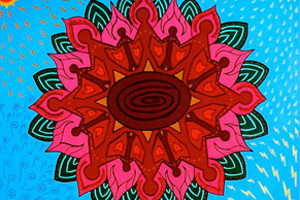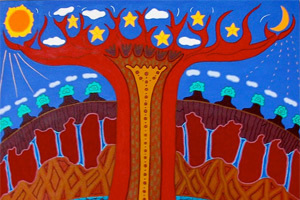The Dance of Life
The Dance of Life is a series of paintings by psychiatrist Professor Helen Milroy, depicting a multi-dimensional model of health and wellbeing from an Aboriginal perspective.
The Dance of Life
This painting brings all dimensions of life together to reflect the delicate balance within the universe. These dimensions include the biological or physical dimension, the psychological or emotional dimension, the social dimension, the spiritual dimension and finally but most importantly, the cultural dimension.
Within each dimension there are additional layers to consider, including the historical context, the traditional and contemporary view as well as our gaps in knowledge.
The potential solutions for healing and restoration of wellbeing come from considering additional factors encompassing issues of symptom presentation and service delivery, such as education and training, policy, the socio-political context and international perspective. As the final painting suggests, we can only exist if firmly grounded and supported by our community and spirituality, whilst always reflecting back on culture in order to hold our heads up high to grow and reach forward to the experiences life has waiting for us.
The stories of our ancestors, the collective grief, as well as healing, begin from knowing where we have come from and where we are heading. From the Aboriginal perspective, carrying the past with you into the future is, as it should be. We are nothing if not for those who have been before us and the children of the future will look back and reflect on us today.
When we enable a person to restore all of the dimensions of their life, then we have achieved a great deal. When all of the dimensions are in balance, within the universe, we can break free of our shackles and truly dance through life.

The Physical Dimension
The physical state cannot be entirely separated from the land itself.
The figure is intimately connected to the earth and gains nurturance from "country" including plants and animals and in turn provides shelter and protection.
This human tree has the sky for a roof, the air for walls and the earth as its floor and does not need artificial constructions.
It freely reaches up to the sky and is warmed by the sun, cooled by the breeze and exists in perfect harmony with the environment.
The headless appearance may represent the grounding of the body in the earth rather than being controlled by the mind. At the end of its days, it returns to the earth to be incorporated into the next landscape, providing a continuity of existence forever.

The Psychological Dimension
The psychological landscape acknowledges the rich two-way connections one makes throughout life from every direction possible.
All stimuli are experienced by all of the senses simultaneously and learning is multi-modal. The central core of psychological life is alive and constantly evolving.
This inner core is supported and protected by collective layers of experience, knowledge, and wisdom and yet the individual is able to perceive for itself the external world and be autonomous in their decisions.
The psychological struggles within are comforted by a collective consciousness, a cushion on which to rest.

The Social Dimension
The social landscape begins by acknowledging the central core of the family tree, with its many rings representing the presence of past generations.
The family stand on the outer ring, linked together with their children and providing for them a place on which to stand.
The shapes formed in between the figures are representative of the hearts shared in the community and the notion that to lose one child will destroy more than one heart.
The family is supported by layers of petals representing society and the environment surrounding the family and keeping it safe from all adversity.
The faces of the family looking inwards show community life is serious business while the faces looking outward show the happiness children bring to society.
This also signifies the more traditional view of constantly reflecting back and looking joyously into the future at the same time.
The shared diagrammatic nature of both the internal and external ring of faces and the location within the universe represents the continuous and intimately connected sense of strength and well-being shared by a community and the enduring relationship to the environment.
When a community stands strong together it blossoms.

The Spiritual Dimension
The spiritual landscape is represented by the tree of life connecting the inner core of the earth to the outer dimensions of the universe.
It not only connects us but also protects us from all things outside our earthly existence.
Life, death, life in this realm is about the richness and intricacies of all of creation of which we form only a very small but essential and irreplaceable part in this never ending cycle.
This timeless dimension with its infinite capacity exists within yet outside of our physical realm.

The Cultural Dimension
The representation of the cultural dimension takes the form of three figures symbolising healing, ceremony and overriding all, traditional law.
All three are intimately connected and weave a pattern throughout life extending into the outer heavens.
The life force flows between the figures indicative of the vibrancy and dynamic nature of culture.
The presence of the campfire symbolises the community orientation as well as the cleansing properties of smoke carrying the burdens of life into the universe.
Culture is grounded in the land we belong to as much of the law, ceremony and healing comes from country.

More information
To learn more about the Dance of Life, view the Dance of Life Matrix [PDF; 329 KB].
